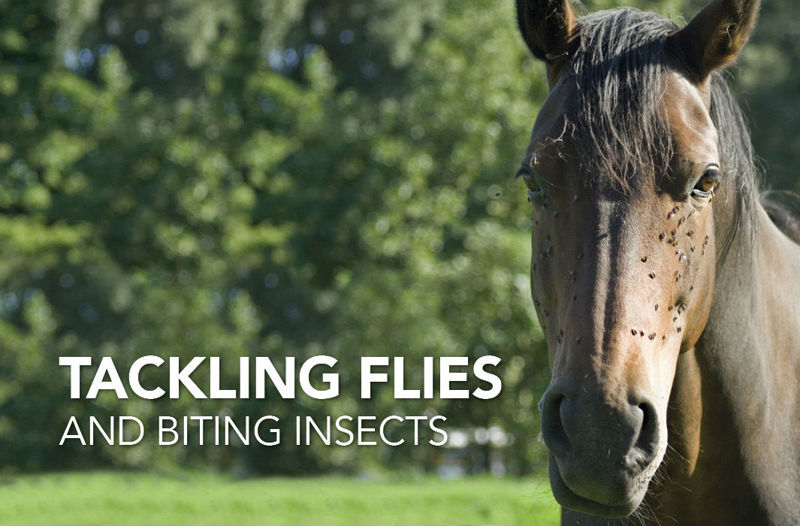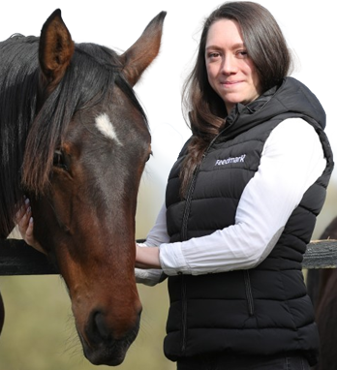After a dreary, wet winter, horse owners are delighted when spring arrives, bringing plenty of welcome sunshine. But as soon as the sun appears, so too do pesky flies. Alongside causing stress to our horses, they can also result in transmission of disease, irritation of the horse’s skin and general discomfort. Hoof damage can also occur through horses stomping their feet to relieve irritation from flies landing on their legs.
Flies use high body temperature, CO2 (from exhalation), and dark coat colours to locate animals to land on1. Horses with darker coats tend to suffer from higher numbers of flies landing on them as flies are attracted to darker coats2.
You’ll know when your horse is being pestered by flies as they will twitch their skin, swish their tails and nod or shake their heads. You might also see an increase in your horse biting and scratching themselves, mutual grooming other horses and seeking the shelter of trees and shade to avoid them. Some horses will stand with their heads by the tail of another horse to have the flies swished away from their faces by the other horse’s tail. In severe cases, horses will act very distressed, running around their paddocks to avoid being bitten.
Did you know?
Horses with darker coats attract more flies on hotter days than lighter coloured horses.
IDENTIFYING FLIES
There’s a variety of different flies that are attracted to horses. They can be identified from one another by where the fly is found on the horse and the horse’s reaction to them3. Common flies that you will find causing irritation to your horse include:
Botfly Gasterophilus spp.
Botfly larvae are extremely common in horses. They are active during late summer. Adult female botflies deposit little cream-coloured eggs on the hair shafts, usually on a horse’s legs, mane and face, and the larvae get ingested when the horse self-grooms or grooms a herd mate. After 4 weeks in the oral cavity, the larvae migrate into the stomach where they stay for up to 10 months. Horse botflies are identified through their fuzzy yellow, brown, or grey bee like appearance. Botflies are extremely host specific and cannot survive in the digestive tracts of other animals. They can cause irritation and distress when laying their eggs, and horses can be seen to fidget and move around to avoid them.
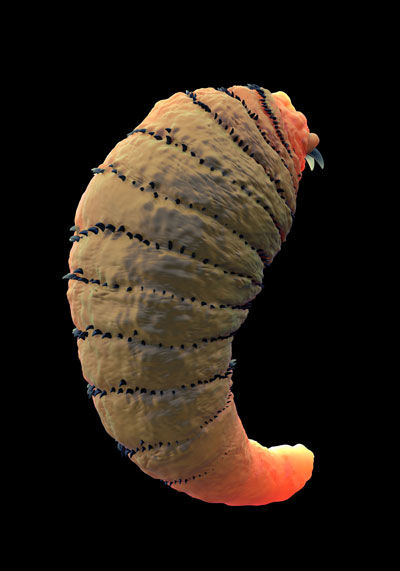
Stable Flies Stomoxys calcitrans
Stable Flies have a similar appearance to house flies, being brownish grey with a chequered abdomen, and a bayonet like proboscis. They are found within the stable and pasture and are prevalent during the summer, with larval and pupal forms developing in decaying organic matter. Stable flies are avid blood feeders with horses being their preferred hosts. The legs, ventral abdomen and ears are where stable flies usually feed via a painful bite3 which causes irritation. Stable flies are mechanical vectors for Equine Infectious Anaemia. They cause the horse to foot stomp, tail shake and bite at their legs3.
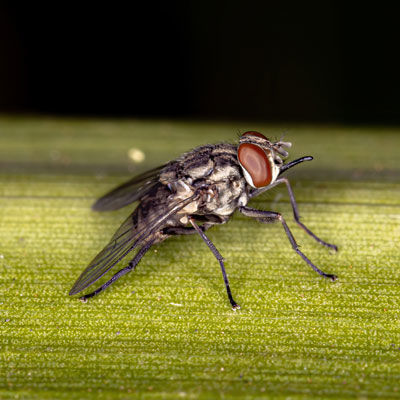
Horse Flies Tabanus ssp.
Horse flies are large, heavy bodied flies with powerful wings and large eyes. Only the females of this species will bite and feed on vertebrates. Adult horse flies lay their eggs in the vicinity of open water. Horse flies are the most difficult blood sucking fly to control as they are intermittent feeders, spending a short amount of time on the horse. Horses will recognise their low-pitched buzzing sound, and will move around and swish their tails to avoid them landing and biting.
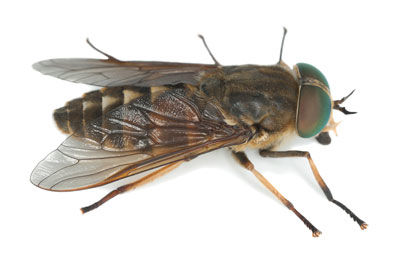
Midge Culicoides ssp.
Culicoides midges are veracious biters and cause intense irritation and annoyance. They are most active at dawn and dusk3 and often feed on the belly, mane, and tail of the horse. Horses can develop fly bite hypersensitivity to Culicoides midge bites leading to extreme itching causing alopecia and thickening of the skin. This reaction is often named ‘Sweet Itch’. Tail swishing, head shaking and kicking up at the belly are most commonly seen when midges are present.
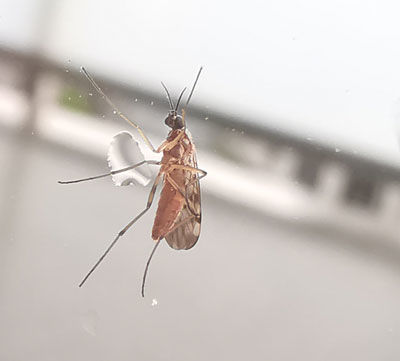
MANAGING FLY BREEDING SITES
One way to reduce the number of flies around your horse is to manage their environment. Manure is used by insects as a breeding ground so poo-picking your paddocks and removing droppings from your horse’s stable regularly will help to limit the number of flies. Composting manure also helps as flies are attracted to fresh manure rather than older, decomposing piles.
Midges and mosquitos breed in stagnant water that is more than five days old, such as water in buckets and water troughs. It’s a good idea to remove any buckets or troughs that could fill with water and become stagnant and ensure you always refresh any water your horse has access to.
Dark and cool spaces are less attractive to flies and biting insects. For horses that suffer badly with flies and insects, such as those with sweet itch or any horses with wounds that need to be kept clean, allow them access to a dark and cool space.
Flies will also find it hard to fly where there is a strong breeze – some owners have been found to use fans in their horse’s stable or will opt to keep their horses on exposed hillsides where a strong airflow helps to avert flies.
DETERING FLIES AND BITING INSECTS FROM YOU HORSE
In addition to managing your horse’s environment and using fly rugs, masks, and repellents, there are holistic ways to help deter flies. Maintaining healthy skin and a shiny coat plays a crucial role in improving your horse's natural resistance to flies and biting insects. These pests are often attracted to breaks in the skin, where they may attempt to lay eggs or invade underlying tissues.
Certain natural dietary strategies can discourage flies and support overall skin health. Ingredients with strong, aromatic properties can pass through the skin, creating an environment less attractive to flies. For example, garlic contains sulfur compounds that are secreted through the skin. Since insects taste through their feet, flies landing on the horse are less likely to bite due to the sulfur's unpleasant taste.
Other natural aromatic herbs, such as fenugreek seeds, lemon peel, peppermint, and rosemary, are also known to repel insects. Additionally, skin-soothing ingredients like chamomile, nettle, and linseed can help support skin health and comfort, especially in areas irritated by flies.
Holistic fly-deterring approaches not only reduce irritation caused by flies but also contribute to your horse's overall wellbeing. Incorporating these strategies into your horse's care routine can help create a more comfortable environment, free from the nuisance of flies and biting insects.
For any advice or questions you may have, please don't hestiate to reach out to our expert nutrition team. You can call 0800 585525 Monday-Friday 8:30am-5:00pm. Email [email protected], or send us a DM on social media.
References
King, S. R., and Gurnell, J. (2010). Effects of fly disturbance on the behaviour of a population of reintroduced Przewalski horses (Equus ferus przewalskii) in Mongolia. Appl. Anim. Behav. Sci. 125, 22–29.
Reubenstein, D.L, & Feinstein, L.H. (2021) Bothersome Flies: How Free-Ranging Horses Reduce Harm While Maintaining Nutrition. Frontiers in Ecology and Evolution. 9
Kaufman, P., Rutz, D., Pitts, C. (2000) Pest management recommendations for horses. Cornell University, Penn State University Cooperative Extension Publication p. 15


